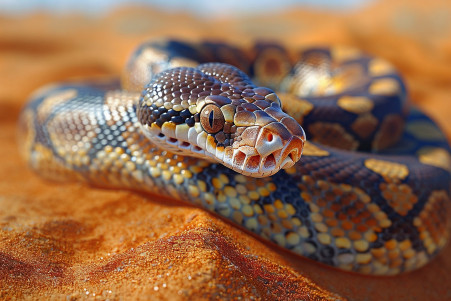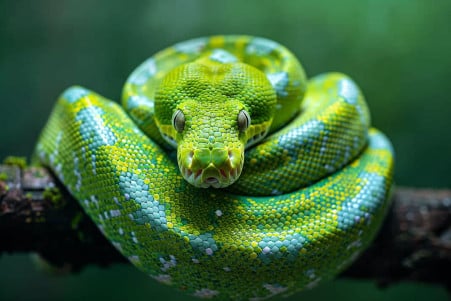How Snakes Use Their Sense of Smell: A Fascinating Insight
14 June 2024 • Updated 13 June 2024

Snakes don't have noses like humans, but they do have a highly developed sense of smell that they use to find food and interact with their environment through a combination of specialized organs and behaviors. Snakes have a forked tongue that collects air particles which are then transferred to jacobson's organs in the roof of their mouth. These biological "noses" analyze odors and allow snakes to track scents over long distances.
We'll take an in-depth look at the scientific literature in biology and herpetology to uncover the intricate ways snakes use their sense of smell. This investigation will reveal the exact anatomical and physiological features that enable snakes to detect scents so effectively. It will also provide insight into the sensory world and evolutionary history of these predators.
How do snakes use their sense of smell?
The Forked Tongue: An Olfactory Adaptation
The forked tongue is an extraordinary adaptation that enables snakes and other reptiles to sample scent molecules from their surroundings. This specialized shape evolved to maximize the surface area available for collecting airborne chemicals, thereby improving the reptile's sense of smell.
When a snake flicks its tongue, the forked tips move apart to sample odors from two different points in space. The two prongs of the tongue deliver their chemical loads to separate vomeronasal organs, allowing the snake to experience "stereo" olfaction and a sense of directionality. This tropotaxis enables snakes to exhibit behaviors like tracking prey or potential mates based on their scent trails.
In addition to collecting molecules, the flicking motion of the tongue creates a jet of air that funnels odors to the vomeronasal organs. By producing vortices in the air, the forked tongue acts as a small fan that draws scent molecules toward the reptile's vomeronasal organs.
This increased olfactory sensitivity was important as snakes adapted to a life underground and their vision became less important. With the improved sense of smell provided by the forked tongue, snakes could more easily find food, escape from predators, and move through their surroundings. The forked tongue is an evolutionary adaptation that was essential to the success of these carnivorous reptiles.
Jacobson's Organ: The Snake's Biological Nose
Jacobson's organ is an important part of a snake's sense of smell, as it processes the heavy, moisture-borne odor particles collected by the forked tongue. Per Britannica, this specialized organ connects to the roof of the snake's mouth, where the odor molecules collected by the tongue can attach to receptor proteins. This activates sensory neurons that send signals to the brain, where the snake can interpret the chemical information.
As the study in the Journal of Experimental Biology notes, Jacobson's organ is highly developed in snakes, with chemosensory cells constantly being produced by basal stem cells. Some of these cells have long dendrites that extend to the surface of the organ, while others have shorter dendrites and are located deeper in the organ. This variety allows Jacobson's organ to detect a wide variety of odor molecules.
Research has found that Jacobson's organ is important in snake communication, as it allows them to detect pheromones that carry information about an individual's sex, age, and reproductive condition. This type of chemical communication is important in courtship, mating, and territorial displays. Meanwhile, the organ's ability to process the scent of potential prey is essential to a snake's hunting abilities, as it helps them find and capture their next meal.
Olfaction: How Snakes Use Their Sense of Smell
The olfactory sense is important for snakes to find and catch their prey. As noted by Pets on Mom.com, snakes "smell" their prey by using their tongues to collect chemical information. When a snake flicks its tongue in and out, it can pick up the scent of a potential meal.
This tongue-flicking behavior helps snakes interpret the chemical signals in their environment. According to research on snake senses, chemical detection is the first step in the sequence of events that leads to a snake finding its prey. The National Park Service goes on to explain that snakes use their tongues to sample the air and carry odor molecules to their vomeronasal organs.
In the case of aquatic snakes, visual cues are used to find the general location where their prey is hiding, as outlined in the Zoological Science study. However, the snakes then use the chemical cues of the prey's scent to find the exact location of their prey and launch an attack. This combination of visual and olfactory cues is what allows aquatic snakes to hunt effectively in the underwater environment.
Snakes can also differentiate between different species of prey based on their scent, as shown in the Zoological Science study on sea snakes. This ability to detect and focus in on specific prey using chemical cues is an important adaptation that helps snakes hunt and survive.
Olfactory Adaptations in Different Snake Species
Snakes have evolved a wide range of olfactory adaptations that are highly specialized to their habitats and prey. The New York Times notes that some studies have even shown that garter snakes can use their sense of smell to recognize themselves, a cognitive skill that was once thought to be unique to more advanced animals.
The olfactory systems of snakes are shaped by their ecological roles. For instance, research has demonstrated that sea snakes have undergone an enormous expansion of the vomeronasal type-2 receptor (V2R) gene family, which has resulted in more than 1,000 gene copies in their genomes. This expansion is an adaptation that helps them smell underwater and enables them to locate and capture prey in the ocean. Meanwhile, fully aquatic mammals such as whales have lost their sense of smell.
Meanwhile, land-dwelling snakes like the Eastern gartersnake have retained a more complex main olfactory system, as shown by research on the loss of olfactory receptor genes in sea snake lineages. This suggests that a snake's olfactory system is related to its social complexity and the demands of its environment.
The diversity of olfactory adaptations in snakes can help scientists learn more about the evolutionary paths that different species have taken and how snakes have managed to live in a variety of environments, from the ocean to the forest.
Pheromones and Chemical Communication in Snakes
Snakes use their vomeronasal system, especially the Jacobson's organ, to detect and process pheromones - chemical signals that carry information about other snakes. Per Pets on Mom.com, the Jacobson's organ enables snakes to "smell" pheromones that other snakes have left behind, which can tell them about the sex, age, and reproductive condition of the other snake.
These pheromone signals are important for snake communication and social interactions. A study in Biology Letters found that young red-sided garter snakes follow the pheromone trails of adults to hibernation sites. Meanwhile, male red-sided garter snakes have been shown to release female pheromones to confuse other males during mating.
Other research has shown that the skin secretions of certain snake species, such as the Vipera ammodytes, contain a rich mix of pheromone compounds, including heavy, semi-volatile ketones. These pheromones are likely used to communicate a variety of information that helps with courtship, mating, and territorial interactions.
The ability to detect these chemical signals is important for snakes as it helps them understand their social and physical surroundings. The snake's impressive vomeronasal system, in combination with its forked tongue and Jacobson's organ, allows it to access a world of smells that humans can't even imagine.
Conclusion: The Hidden World of Snake Olfaction
Snakes have an amazing sense of smell that is critical to their survival and success as predators. This keen olfactory ability is made possible by a number of specialized adaptations, including the snake's forked tongue and Jacobson's organ.
The snake's forked tongue is a highly effective scent-collecting tool. It samples odors from multiple points, enabling the snake to track chemical trails, as it flicks in and out. In addition, the tongue's shape and movement create airflow that helps deliver odors to the snake's biological "noses."
These biological "noses" are the Jacobson's organs, which are located in the roof of the snake's mouth. They are specially designed to detect heavy, moisture-borne odor particles collected by the tongue and convert them into sensory signals that the snake's brain can interpret. In addition to helping snakes find food and avoid predators, Jacobson's organs are also important for snake communication, enabling them to detect pheromones that convey information about an individual's sex, age, and reproductive status.
The diversity of olfactory adaptations across snake species is truly amazing. For example, some aquatic snakes have expanded vomeronasal receptor genes that help them detect scents underwater, while terrestrial snakes have more robust main olfactory systems. These adaptations are tailored to the specific needs and challenges of each species' environment and are essential to their survival and success.
In the end, snakes live in a world that is rich with scents that we can't detect. Thanks to their anatomical adaptations and sensory abilities, these reptiles have evolved to thrive in a world of smell that is beyond our wildest imaginations.
As we learn more about snake olfaction, we also learn more about the sensory world of these fascinating predators. While the snake's world of scents is largely invisible to us, it's a testament to the evolutionary creativity and adaptability of these amazing reptiles.


